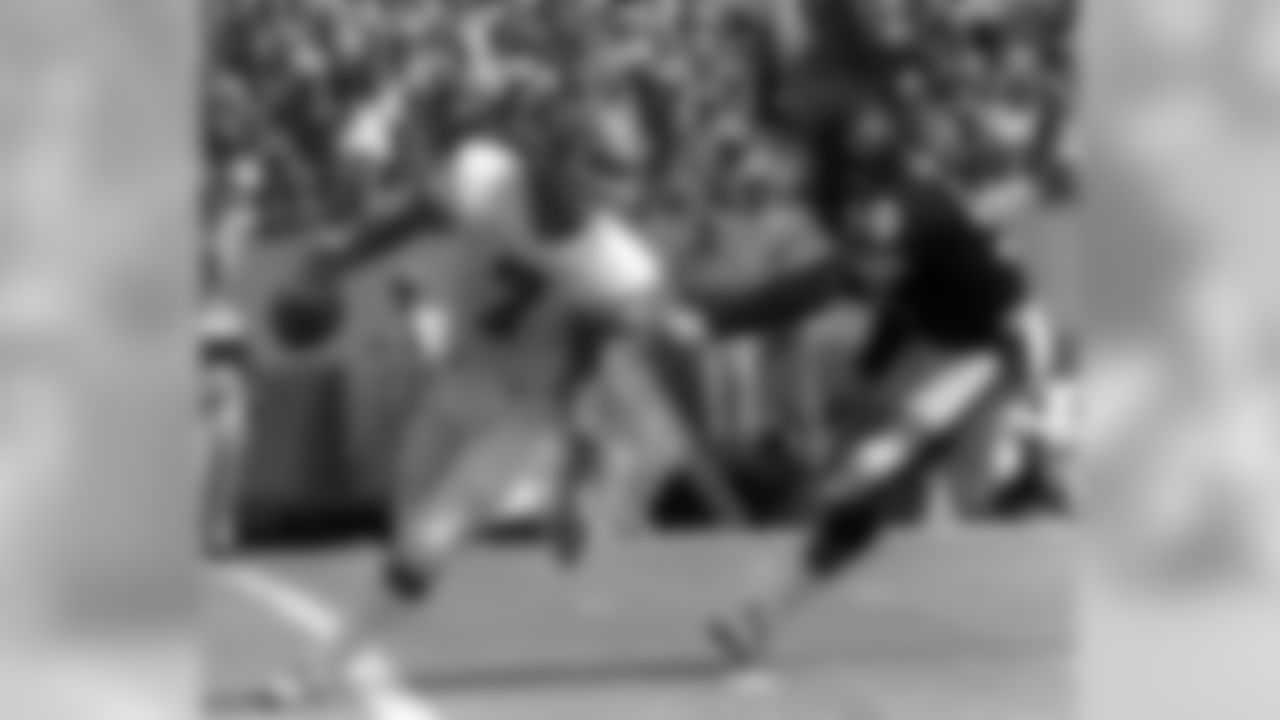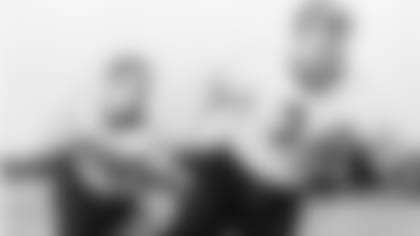Denver and Chicago have played 14 all-time regular-season games, dating to Dec. 5, 1971.

Denver's Louis Wright grabs hold of the Bears' Walter Payton while Chicago's Jeff Sevy attempts to break his grasp in the first quarter on Sunday, Dec. 12, 1976 in Chicago.

Broncos quarterback Norris Weese eludes Chicago linebacker Don Rives on Dec. 12, 1976 at Soldier Field in Chicago.

Chicago's Alan Page, left, reaches for Denver running back Lonnie Perrin during the first half on Oct. 16, 1978 in Denver.

Denver quarterback John Elway looks back as Chicago's Al Harris closes in during the second quarter on Oct. 2, 1983 in Chicago.

Chicago's Walter Payton rushes during first-quarter action against the Denver Broncos on Sept. 9, 1984, at Solider Field in Chicago.

Denver running back Rod Bernstine runs up the middle in a muddy game against the Bears on December 18, 1993 at Soldier Field in Chicago.

Chicago defensive end Richard Dent, left, is blocked by Broncos tight end Shannon Sharpe on Dec. 18, 1993 at Soldier Field in Chicago.

Chicago quarterback Kordell Stewart, left, leaps over Bears guard Chris Villarrial and Broncos linebacker Al Wilson for a touchdown against the Broncos in the fourth quarter Sunday, Nov. 23, 2003 in Denver.

Broncos defensive tackles Marcus Thomas (79) and Ryan McBean (98) try and block a field-goal try from Bears kicker Robbie Gould (9) on Sunday, Dec. 11, 2011 in Denver.

Denver quarterback Tim Tebow scrambles against the Chicago Bears on Sunday, Dec. 11, 2011.

Broncos running back Willis McGahee, middle, runs against the Chicago Bears in Denver on Sunday, Dec. 11, 2011.




When a team has the Chicago Bears on its schedule, as the Denver Broncos do this week, the aura of legacy and legend loom large over the entire moment.
Chicago. The City of the Big Shoulders.

The Bears. The Monsters of the Midway. They had nine titles to their name before the NFL calendar turned to the year 1950.
This is just the Broncos' seventh game ever in Chicago, but the Bears are integral to the history of pro football.
They played as the Chicago Staleys as early as 1921, but on June 24, 1922 the pro football league changed its name to the "National Football League" and the Staleys were sold to their player/coach, George Halas.
One year later they changed their name to the Bears, and Halas, a proud University of Illinois graduate, chose a deep, navy blue and orange for the Bears because they were the colors of his beloved Illini.
They became so powerful, so fast, that they earned that moniker of the "Monsters of the Midway."
The Bears were the stuff of legend.
At my very first Super Bowl that I worked for the league (Super Bowl XVIII in Tampa), I got to be on the field at the same time as the greatest "Monster" ever, Bronko Nagurski, who was making his last public appearance, tossing the coin for that Super Bowl game.
No one who ever saw him or shook his hand can forget the size of those hands--to this day the largest ring ever made for an inductee by the Pro Football Hall of Fame is the one for Nagurski, with the only debate being whether it was an 18 and 1/2, or merely a size 18.
While he was at Minnesota, he made write Grantland Rice's 1929 All-America team at two positions, as Nagurski made the team as both starting fullback and a starting tackle.
His talents were so great that during World War II, with Nagurski having been retired for three seasons, Halas persuaded him back with the pledge that he would just be asked to block, not carry the ball (and the piles of tacklers on his back). His role as a blocking fullback was so dominant that Chicago produced the first 1,000-yard rusher in NFL history, halfback Beattie Feathers.

The colorful nature of the Bears was not limited to the field, as there was colorful activity in the stands as well.
Many books on the early years of pro football document how gambling not only took place in the stands during games, but members of Chicago organizations that were involved in such things actually roamed among customers taking bets during the game.
Fans are quite familiar with Soldier Field, and many know that the Bears once played in Wrigley Field (and by the way, if the "official" foul line dimensions of Wrigley Field are accurate, how come a football field had trouble fitting in? Just saying.), but few know that the Bears actually hosted the first indoor game in pro football history.
That was at the venerable old Chicago Stadium after the 1932 season. The Bears and Portsmouth Spartans (who later became the Detroit Lions) had both gone undefeated, and while there was no official championship game that year (the league title game started the following season) it was concluded that the Bears and Spartans would play a winner-take-all game in Chicago.
But Mother Nature intervened with a huge snowstorm that made it impossible to clear the field in time, so Halas suggested they adjust the field dimensions a bit and play in Chicago Stadium.
They did, but many a player cursed Halas, good naturedly and some not so much. See, the circus had just played Chicago Stadium; circuses have elephants; elephants produce a lot of dung, and they went from playing in snow to playing in sawdust and other stuff.

But they played the first indoor championship game in history, and the Bears beat the Spartans, 9-0.
Of course, the Broncos are facing former head coach John Fox and quarterback Jay Cutler, but the Bears and Broncos actually have a Hall of Fame member in common.
Stan Jones was a great defensive lineman for the Bears from 1954 through 1965, making seven consecutive Pro Bowls and the Hall of Fame in the process.
Considered the first player to use weightlifting as part of his offseason training regimen, Stan was later the Broncos' defensive line coach for 18 years in the 1960s, '70s and '80s.
Stan remains the best storyteller regarding the early years of pro football that we have ever had on our staff, and I remember him fondly from our many days together.
You can never play the Bears without giving some testimony to their expansive role in pro football history, from Halas and Nagurski to back-to-back Hall of Fame draft choices Gale Sayers and Dick Butkus, to the sports entertainment behemoth which we all are part of today.
In pro football, legends come to life and new ones are made as well, which brings us to this week's chapter of the magic moments that define pro football.














